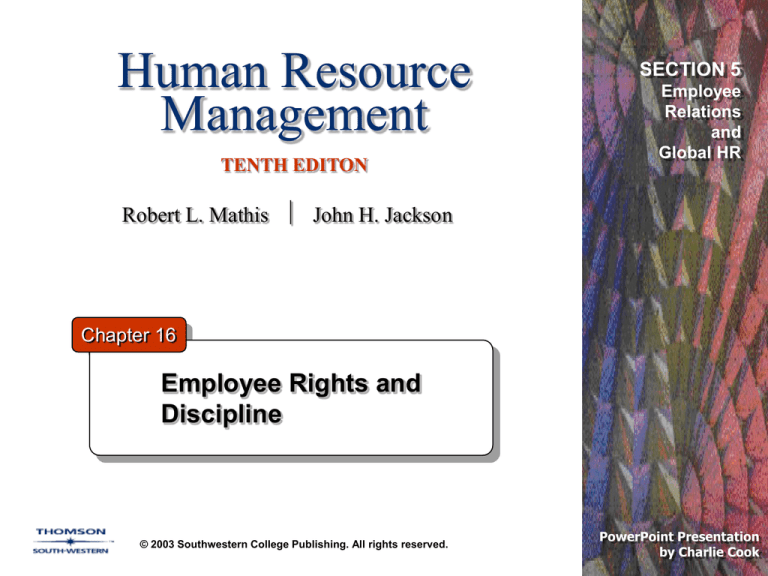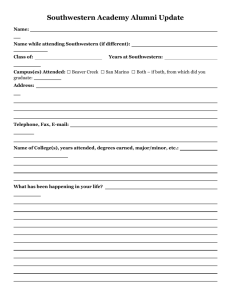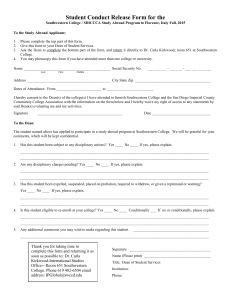
Human Resource
Management
TENTH EDITON
SECTION 5
Employee
Relations
and
Global HR
Robert L. Mathis John H. Jackson
Chapter 16
Employee Rights and
Discipline
© 2003 Southwestern College Publishing. All rights reserved.
PowerPoint Presentation
by Charlie Cook
Learning Objectives
After you have read this chapter, you should be
able to:
– Explain the difference between statutory rights and
contractual rights.
– Define employment-at-will and identify three
exceptions to it.
– Describe what due process is and explain some
means of alternative dispute resolution.
– Identify employee rights associated with access to
employee records and free speech.
© 2002 Southwestern College Publishing. All rights reserved.
16–2
Learning Objectives (cont’d)
– Discuss issues associated with workplace
monitoring, surveillance, investigations, and drug
testing.
– List elements to consider when developing an
employee handbook.
– Differentiate between the positive approach and the
progressive approach to discipline.
© 2002 Southwestern College Publishing. All rights reserved.
16–3
Rights and Responsibilities Issues
Rights
– That which belongs to a person by law, nature, or
tradition.
Responsibilities
– Obligations to be accountable for actions.
Statutory Rights
– Rights based on specific laws and statutes passed
by federal, state, and local governments.
© 2002 Southwestern College Publishing. All rights reserved.
16–4
Typical Employment Contract Provisions
Figure 16–1
© 2002 Southwestern College Publishing. All rights reserved.
16–5
Contractual Rights
Key Terms
Contractual Rights
Rights based on a specific contractual
agreement between employer and employee.
Separation Agreement
Agreement in which an employee who is
being terminated agrees not to sue the
employer in exchange for specified benefits.
Employment Contract
Agreement that formally outlines the details
of employment.
Non-Compete
Agreement
An agreement that prohibits an individual
who leaves the organization from competing
with the employer in the same line of
business for a specified period of time.
Implied Contract
The idea that a contract exists between the
employer and the employee based on the
implied promises of the employer.
© 2002 Southwestern College Publishing. All rights reserved.
16–6
Employment Practices Liability Insurance
Employment Practices Liability Insurance (EPLI)
– Covers employer’s costs for legal fees, settlements,
and judgments associated with employment-related
actions such as:
•
•
•
•
•
•
•
•
•
Discrimination
Wrongful discipline
Sexual harassment
Wrongful termination
Negligent evaluation
Infliction of emotional distress
Breach of employment contract
Deprivation of career opportunity
Improper management of employee benefits
© 2002 Southwestern College Publishing. All rights reserved.
16–7
Rights Affecting the Employment Relationship
Employment-at-Will (EAW)
– A common law doctrine stating that employers have
the right to hire, fire, demote, or promote
whomever they choose, unless there is a law or
contract to the contrary.
– Employees have the right to quit and got another
job under the same constraints.
Wrongful Discharge
– Termination of an individual’s employment for
reasons that are improper or illegal.
– Fortune v. National Cash Register
© 2002 Southwestern College Publishing. All rights reserved.
16–8
Employment-at-Will (EAW)
Exceptions to EAW
Public Policy
An employee can sue an employer if he or
she was fired for refusing the employer’s
demand to violate public policy (“break the
law”).
Implied Employment
Contract
An employee can sue an employer if the
employer’s actions or inaction constitute an
implied contract of continuing employment.
Good Faith and Fair
Dealing
If the employer’s unruly behavior breaks a
covenant of good faith with the employee,
then that employee can sue the employer.
© 2002 Southwestern College Publishing. All rights reserved.
16–9
Sample
Employmentat-Will
Statement
Figure 16–2
© 2002 Southwestern College Publishing. All rights reserved.
16–10
Keys for Defense in Wrongful Discharge:
The “Paper Trail”
Figure 16–3
© 2002 Southwestern College Publishing. All rights reserved.
16–11
Just Cause
Just Cause
– Reasonable justification for taking an employmentrelated action.
Constructive Discharge
– An employer deliberately makes working conditions
intolerable for an employee in an attempt to get (to
force) that employee to resign or quit.
© 2002 Southwestern College Publishing. All rights reserved.
16–12
Due Process
Due Process
– The means used for individuals to explain and
defend their actions against charges or discipline.
Distributive Justice
– Perceived fairness in the distribution of outcomes.
Procedural Justice
– Perceived fairness of the process used to make
decision about employees.
© 2002 Southwestern College Publishing. All rights reserved.
16–13
Criteria for Just Cause and Due Process
Figure 16–4
© 2002 Southwestern College Publishing. All rights reserved.
16–14
Alternative Dispute Resolution (ADR)
Arbitration
Peer Review Panel
Alternative
Dispute
Resolution
Organizational
Ombudsman
© 2002 Southwestern College Publishing. All rights reserved.
16–15
Examples of Four-Step ADR Approaches
Source: Adapted from “HR Shop Talk,” Bulletin to Management, May 25, 2000, 166;
and “Alternative Dispute Resolution,” Bulletin to Management, August 3, 2001, 247.
© 2002 Southwestern College Publishing. All rights reserved.
Figure 16–5
16–16
Balancing Employer Security Concerns
and Employee Rights
Right to Privacy
– Defined in legal terms for individuals as the
freedom from unauthorized and unreasonable
intrusion into their personal affairs.
Privacy Rights and HR Records:
– Access to personal information held by employer
– Response to unfavorable information in records
– Correction of erroneous information
– Notification when information is given to a third
party
© 2002 Southwestern College Publishing. All rights reserved.
16–17
Employee Records
ADA Provisions
– Employee medical records are to be kept as
separate confidential files available under limited
conditions specified in the ADA.
HR Records’ Security
– Restrict access to all HR records
– Utilize confidential passwords to HRIS databases
– Place sensitive information in separate files and
restricted databases
– Inform employees of types of data to retain
– Purge outdated data from records
– Release information only with employee’s consent
© 2002 Southwestern College Publishing. All rights reserved.
16–18
Employee Record Files
Figure 16–6
© 2002 Southwestern College Publishing. All rights reserved.
16–19
Employee Free Speech Rights
Advocacy of
Controversial
Views
Tracking
Employee
Internet Usage
Free
Speech
Rights
Whistle-Blowing
Monitoring of
E-Mail/Voice Mail
© 2002 Southwestern College Publishing. All rights reserved.
16–20
Keeping Tabs on Employees Online
Source: Adapted from data in “Keeping Tabs in Employees
Online,” Business Week, February 19, 2001, p. 16.
© 2002 Southwestern College Publishing. All rights reserved.
Figure 16–7
16–21
Methods of Dealing with Workplace Theft
Figure 16–8
© 2002 Southwestern College Publishing. All rights reserved.
16–22
Impact of Substance Abuse on Employers
Figure 16–9
© 2002 Southwestern College Publishing. All rights reserved.
16–23
Drug Testing and Employee Rights
Arguments Against Drug Testing
– It violates employees’ privacy rights.
– Drugs may not affect performance in every case.
– Employers may abuse the results of tests.
– Drug tests may be inaccurate.
– Test results can be misinterpreted.
Types of Drug Testing
– Urinalysis
– Hair immunoassay
– Fit-for-duty tests for impairment
© 2002 Southwestern College Publishing. All rights reserved.
16–24
Drug Testing
Conducting Drug Tests
– Random testing of all employee at periodic intervals
– Testing only in cases of probable cause
– Testing after accidents
When to Test (Conditions)
– Job consequences outweigh privacy concerns
– Accurate test procedures are available
– Written consent of the employee is obtained
– Results are treated confidentially
– Employers have a complete drug program, including
an EAP.
© 2002 Southwestern College Publishing. All rights reserved.
16–25
HR Policies, Procedures, and Rules
Policies
– General guidelines that focus organizational actions.
• “Why we do it”
Procedures
– Customary methods of handling activities
• “How we do it”
Rules
– Specific guidelines that regulate and restrict the
behavior of individuals.
• “The limits on what we do”
© 2002 Southwestern College Publishing. All rights reserved.
16–26
Typical Division of HR Responsibilities:
Policies and Rules
Figure 16–10
© 2002 Southwestern College Publishing. All rights reserved.
16–27
Employee Handbooks
Legal Review of Language
– Eliminate controversial phrases in wording.
– Use disclaimers disavowing handbook as a contract.
– Keep handbook content current.
Readability
– Adjust reading level of handbook for intended
audience of employees.
Use
– Communicate and discuss handbook.
– Notify all employees of changes in the handbook.
© 2002 Southwestern College Publishing. All rights reserved.
16–28
Communicating HR Information
Communicating
HR Information
HR Publications
and Media
E-Mail and
Teleconferencing
© 2002 Southwestern College Publishing. All rights reserved.
Suggestion
Systems
16–29
Employee Discipline
Discipline
– A form of training that enforces organizational
rules.
Positive Discipline Approach
1. Counseling
2. Written Documentation
3. Final Warning (decision day-off)
4. Discharge
© 2002 Southwestern College Publishing. All rights reserved.
16–30
Typical Division of HR Responsibilities: Discipline
Figure 16–11
© 2002 Southwestern College Publishing. All rights reserved.
16–31
Progressive Discipline Procedure
Figure 16–12
© 2002 Southwestern College Publishing. All rights reserved.
16–32
Reasons Why Discipline Might Not Be Used
Organization culture regarding discipline
Lack of support by higher management
Guilt
Loss of friendship
Time loss
Fear of lawsuits
© 2002 Southwestern College Publishing. All rights reserved.
16–33
The Hot Stove Rule
Good discipline (or a rule) is like a hot stove in
that:
– It
– It
– It
– It
provides a warning (feels hot)
is consistent (burns every time)
is immediate (burns now)
is impersonal (burns all alike)
© 2002 Southwestern College Publishing. All rights reserved.
16–34
Discharge: The Final Disciplinary Step
Handling Discharges
– Provide discharge warning at last disciplinary step
before termination.
– Provide the employee with written notice of the
discharge that clearly states the reason(s) for the
discharge decision, do not try to “sugarcoat” the
reason(s).
– Have an HR representative attend the termination
meeting as a witness.
– Inform the employee of HR or benefits issues.
– Maintain a professional demeanor at all times.
© 2002 Southwestern College Publishing. All rights reserved.
16–35




